 W
WAcanthopidae is a family of mantises consisting of 16 genera in the order Mantodea. The group was first formally split off as a separate family by the German entomologist Reinhard Ehrmann in 2002. In 2016, five genera were moved from Acanthopidae to the newly created family Acontistidae, but this has not been accepted in most recent classifications.
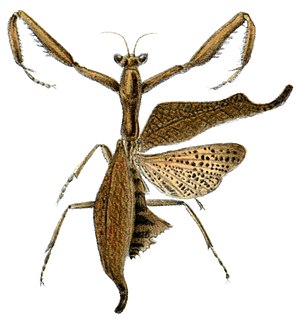 W
WAcanthops falcataria, common name South American dead leaf mantis, is a species of praying mantis in the family Acanthopidae. It is not to be confused with Acanthops falcata, a different species in the same genus that is often referred to with the same common name.
 W
WAcontista is a genus of mantises in the family Acanthopidae.
 W
WAcontista concinna is a species of praying mantis in the family Acanthopidae that is native to Ecuador.
 W
WAcontistini is a tribe of neotropical mantids in the superfamily Acanthopoidea, and family Acanthopidae. There are 7 genera and more than 30 described species in Acontistini. In 2016, several genera were moved from Acanthopidae to a newly created family Acontistidae, but this has not been accepted in most recent classifications.
 W
WAethalochroa is a genus of praying mantis in the family Toxoderidae.
 W
WAfrican mantis and African praying mantis are common names for many species of praying mantis native to Africa.
 W
WAmorphoscelis elegans is a species of praying mantis found in Ghana, Guinea, Togo, and on Bioko island.
 W
WAmorphoscelis pulchella is a species of praying mantis found in Angola, Uganda, Zimbabwe and the Congo River region.
 W
WAmorphoscelis tuberculata is a species of praying mantis native to Namibia, Mozambique, Transvaal, Zimbabwe.
 W
WAstape is a genus of praying mantis in the family Haaniidae, containing the single species Astape denticollis.
 W
WBark mantis is a common name given to various species of praying mantis, especially those with cryptic camouflage resembling tree bark. Examples include:Gyromantis kraussii Gyromantis occidentalis Paraoxypilus sp. Tarachodes sp. Theopompa sp.
 W
WBistanta is a monotypic genus of praying mantises in the family Thespidae. It is represented by a single species, Bistanta mexicana.
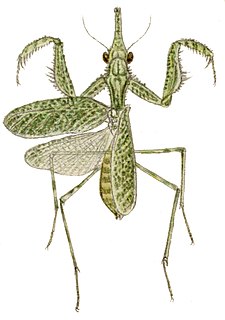 W
WBlepharodes cornutus is a species of praying mantis in the genus Blepharodes in the order Mantodea.
 W
WBlepharopsis is a genus of praying mantis in the family Empusidae. This genus has only one species, Blepharopsis mendica.
 W
WBlepharopsis mendica is a species of praying mantis found in North Africa, parts of the Mediterranean, Middle East and southern Asia, and on the Canary Islands. Devil's flower mantis, Egyptian flower mantis, thistle mantis, and Arab mantis are among its common names.
 W
WBolbe is a genus of praying mantises, sometimes called by the common name Ground Mantis, that is found in Australia. It is in the family Iridopterygidae of the order Mantodea, the mantis.
 W
WBolbe pygmaea is a species of praying mantis in the genus Bolbe in the family Iridopterygidae of the order Mantodea. It is endemic to Australia.
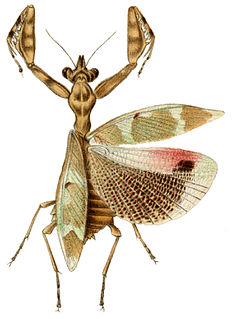 W
WCallibia is a genus of praying mantis in the family Acanthopidae. The genus consists of only one species, Callibia diana.
 W
WChaeteessa is a genus of mantis in the monotypic family Chaeteessidae and subfamily Chaeteessinae, containing six species found in South America:Chaeteessa burmeisteri Chaeteessa caudata Chaeteessa filata Chaeteessa nana Chaeteessa nigromarginata Chaeteessa valida
 W
WCiulfina is a genus of small, tree-dwelling praying mantises belonging to the Family Nanomantidae and native to Australia. The following species may be found in eastern Queensland and Northern Australia:C. baldersoni C. biseriata C. klassi C. liturgusa C. rentzi
 W
WCoptopterygidae is a family of mantids in the order Mantodea. There are at least 2 genera and more than 20 described species in Coptopterygidae.
 W
WDead leaf mantis is a common name given to various species of praying mantis that mimic dead leaves. It is most often used in reference to species within genus Deroplatys because of their popularity as exotic pets. Examples include D. desiccata, D. lobata, and D. philippinica. Other species to which the term may apply include Acanthops falcataria, A. falcata, and Phyllocrania paradoxa.
 W
WDecimiana is a genus of mantises in the family Acanthopidae.
 W
WEmpusa is a genus of mantises in the family Empusidae, containing the following species:
 W
WEmpusa pennata, or the conehead mantis, is a species of praying mantis in genus Empusa native to the Mediterranean Region. It can be found in Portugal, Spain, southern France, Italy and on the mediterranean coasts of Morocco, Algeria, Tunisia, Libya and Egypt. Because of its fragmented, low density populations, it is very rarely found in nature.
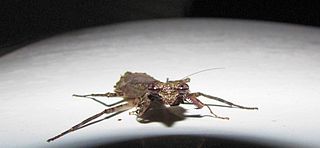 W
WGonatista is a genus of praying mantises in the family Epaphroditidae.
 W
WGongylus is a genus of empusids in the order Mantodea. Characterized by extremely slender limbs with large appendages, at least one species is kept as a pet by hobbyists. Males of the species are capable of flight.
 W
WGongylus gongylodes, also known as the wandering violin mantis, ornate mantis, or Indian rose mantis, is an insect of the order Mantodea. Characterized by extremely slender limbs with large appendages. It is not a particularly aggressive species and often kept as a pet by hobbyists. The mantis is especially known for swaying its body back and forth to imitate a stick flowing in the wind. It primarily feeds on flying insects. Its native range is in southern India and Sri Lanka. It can reach up to 11 cm long. The males of the species are capable of flight. This species is a communal species in that they live and breed in large groups without unnecessary cannibalism.
 W
WGongylus trachelophyllus is an insect of the order Mantodea which is characterized by extremely slender limbs with large appendages.
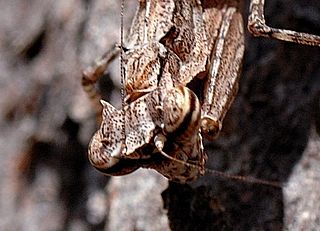 W
WGyromantis kraussi, the spiny bark mantis, is a member of the mantis family. It is native to Australia.
 W
WLiturgusa maya is a species in the order Mantodea ("mantids"), in the class Insecta ("insects").
 W
WMantoida is a genus containing eleven species of mantis. It is placed in family, Mantoididae.
 W
WMantoida nitida is a species of praying mantis in the Mantoididae family.
 W
WMetallyticus splendidus is a very rare species of praying mantis found in Southeast Asia. It has an iridescent appearance.
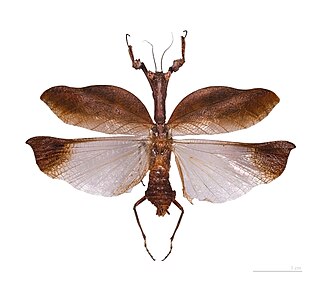 W
WMetilia amazonica is a species of mantis of the family Acanthopidae that was historically Acanthops amazonica.
 W
WMetilia brunnerii is a species of mantis of the family Acanthopidae.
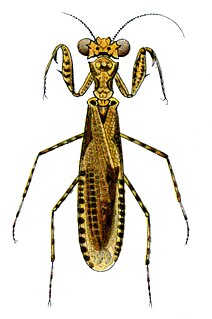 W
WMetoxypilus spinosus is a species of praying mantis found in New Guinea.
 W
WMyrmecomantis atra, common name ant mantis, is a species of praying mantis that relies upon ant mimicry for protection even as an adult.
 W
WOligonicella is a wide-ranging genus of mantises in the family Thespidae. It is represented in Africa, Asia, Europe, and North America.
 W
WParaoxypilus is a genus of mantis, known as the boxer bark mantids. Some are native to Australia and Oceania.
 W
WPhotinaidae is a family of mantids in the order Neotropical Mantodea, in the superfamily Acanthopoidea. There are about 11 genera and more than 40 described species in Photinaidae.
 W
WSibylla is a genus of mantises in the family Hymenopodidae consisting of 13 species. They have a long and thin prothorax with lateral and dorsal projections. The head bears an erect process with four sideways spikes.
 W
WSibylla pretiosa, commonly known as the cryptic mantis, is a species of mantis found in southern Africa. They have a long and thin prothorax. The distinctively ornamented species has projections on the head, prothorax, and four femora. They live on tree bark in woodlands.
 W
WSibyllinae is subfamily of mantises in the family Hymenopodidae. It was formerly classified as a separate family, Sibyllidae.
 W
WStenophylla is a genus of praying mantis in the subfamily Stenophyllinae, which is now placed in the family Acanthopidae. It the sole genus of the tribe Stenophyllini.
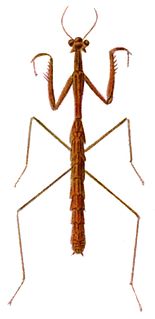 W
WStick mantis and twig mantis are common names applied to numerous species of mantis that mimic sticks or twigs as camouflage. Often the name serves to identify entire genera such as is the case with:Brunneria Hoplocorypha Paratoxodera Popa
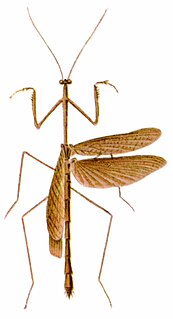 W
WThesprotia is a genus of mantises commonly known as grass mantis. They are native to the Americas and are represented by the following species:T. brasiliensis T. brevis T. caribea T. filum T. fuscipennis T. gigas T. graminis T. infumata T. insolita T. macilenta T. maculata T. pellucida T. simplex T. subhyalina
 W
WTropidomantis tenera or Tropidomantis (Tropidomantis) tenera is a species of praying mantis found in Thailand, Malaysia, Sumatra, Java, Flores, Sumba, Sulawesi, Borneo, and the Philippines. Females reach about 2.5 cm in length, and males are smaller.